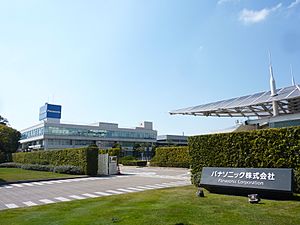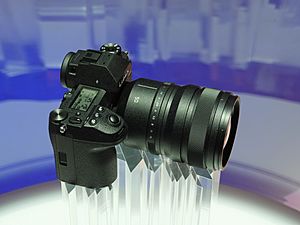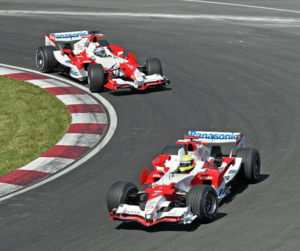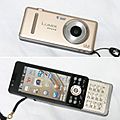Panasonic facts for kids

Headquarters in Kadoma, Japan
|
|
|
Native name
|
パナソニック ホールディングス株式会社
|
|---|---|
|
Romanized name
|
Panasonikku Hōrudingusu kabushiki gaisha |
|
Formerly
|
|
| Public | |
| Traded as | |
| ISIN | [https://isin.toolforge.org/?language=en&isin=JP3866800000 JP3866800000] |
| Industry | Conglomerate |
| Founded | March 7, 1918 |
| Founder | Kōnosuke Matsushita |
| Headquarters | Kadoma, Osaka, Japan 34°44′38″N 135°34′12″E / 34.7438°N 135.5701°E |
|
Area served
|
Worldwide |
|
Key people
|
|
| Brands |
|
| Revenue | |
|
Operating income
|
|
| Total assets | |
| Total equity | |
|
Number of employees
|
228,420 (2024) |
| Subsidiaries |
|
Panasonic Holdings Corporation is a giant Japanese company that makes all kinds of electronics. Its main office is in Kadoma, Japan. The company was started way back in 1918 by a man named Kōnosuke Matsushita.
For a long time, Panasonic was the biggest maker of consumer electronics in the world. Today, it makes a huge variety of products. These include rechargeable batteries, systems for cars and airplanes, and even equipment for home building.
Contents
What's in a Name?
For most of its history, the company was called Matsushita Electric Industrial Co. But in 2008, it changed its name to Panasonic Corporation. This was because "Panasonic" was its most famous brand name around the world.
In 2022, the company changed its structure to become a holding company. This is a way to organize a large business with many different parts. The main company is now called Panasonic Holdings Corporation.
Famous Brand Names
Panasonic sells most of its products under the Panasonic brand. Its slogan is "A Better Life, A Better World." But over the years, it has used other names too.
- National: In 1927, the company started using the brand name "National" for its products in Japan.
- Panasonic: In 1955, the company needed a name for products sold outside of Japan. They came up with "Panasonic" from the words "pan" (meaning "all") and "sonic" (meaning "sound").
- Technics: In 1965, the "Technics" brand was created for high-quality audio equipment. This brand is famous for its turntables, like the SL-1200.
By 2003, the company decided to make Panasonic its main global brand.
The History of Panasonic
Panasonic was started in 1918 by Kōnosuke Matsushita. At first, his company sold simple lamp sockets. By the 1920s, it was making new products, like bicycle lamps sold under the "National" brand.
After World War II, the company helped Japan rebuild by making radios, appliances, and bicycles. It grew very quickly.
Going Global
In 1961, Kōnosuke Matsushita traveled to the United States. Soon after, his company began making television sets for the U.S. market under the Panasonic brand name. The company became a huge success. It made all sorts of new electronics, like:
- Black and white TVs (1952)
- Refrigerators (1953)
- Rice cookers (1959)
- Color TVs and microwave ovens (1966)
In 1972, Panasonic built its first factory outside of Japan, in Malaysia.
New Technology in the 80s and 90s
In 1983, Panasonic launched the Panasonic Senior Partner. It was the first Japanese-made computer that was fully compatible with IBM PCs.
In 1990, the company bought the American media company MCA Inc., which owned Universal Pictures. Panasonic hoped to become a leader in the movie industry, just as its rival Sony had done. However, the movie business was very different from electronics, and Panasonic sold most of MCA in 1995.
Panasonic in the 21st Century
In 2008, the company officially changed its name to Panasonic Corporation. A year later, it bought another big electronics company, Sanyo.
Panasonic became famous for its high-quality plasma TVs. When another company, Pioneer, stopped making its popular "Kuro" plasma TVs, Panasonic bought many of their ideas and used them to make its own TVs even better.
In recent years, Panasonic has focused more on new areas, like batteries for electric cars.
Working with Tesla
In 2014, Panasonic agreed to work with Tesla Motors to build the Gigafactory. This is a massive factory in Nevada, USA, that makes batteries for Tesla's electric vehicles. Panasonic became the main supplier of batteries for Tesla's popular Model 3 car.
New Directions
Panasonic has continued to change with the times. In 2019, it sold its business that made semiconductors (computer chips). It also stopped making LCD panels to focus on products for cars and other industries.
In 2021, Panasonic bought a software company called Blue Yonder. This company helps businesses manage their supply chain (the process of getting products from the factory to the customer).
What Panasonic Does Today
Panasonic is a global company with many different parts. Its main business areas are:
- Appliances: Making things for the home like refrigerators and washing machines.
- Life Solutions: This includes building materials and even entire homes through its Panasonic Homes division.
- Connected Solutions: This part of the company makes systems for airplanes, like the entertainment screens on the back of seats.
- Automotive: Making electronics for cars, including sound systems and batteries.
- Industrial Solutions: Creating components for other companies to use in their products.
Batteries for Electric Cars
Panasonic is one of the world's biggest makers of batteries for electric vehicles. Besides its partnership with Tesla, Panasonic also works with Toyota in a joint company called Prime Planet Energy & Solutions. They are also building new battery factories in the United States to meet the growing demand for electric cars.
Cool Products from Panasonic
Panasonic has made a wide range of famous products over the years.
- Televisions: For decades, Panasonic was a top name in TVs.
- Cameras: The Lumix brand of digital cameras is very popular with both amateur and professional photographers.
- Audio Equipment: The Technics brand is legendary for its high-quality turntables and headphones.
- Toughbook Computers: These are super-strong laptops designed to be used by police, soldiers, and construction workers in tough conditions.
- Home Appliances: From air conditioners to rice cookers, Panasonic makes many devices that people use every day.
Panasonic and Sports
Panasonic has a long history of sponsoring sports teams and events.
- It is a top-level sponsor of the Olympic Games and has been since 1988.
- It owns a Japanese professional football (soccer) team called Gamba Osaka.
- It was a major sponsor of the Toyota Racing Formula One team.
- It sponsors the Jaguar Racing team in the Formula E electric car racing series.
- It sponsors Japanese IndyCar Series driver Takuma Sato.
Taking Care of the Planet
Panasonic works to make its products energy-efficient and reduce its impact on the environment. The company is praised for making many products that are free from harmful plastics like PVC.
In 2020, Panasonic joined an organization called WIPO GREEN. This group helps share green technologies to fight climate change. The company has also worked to make its factories produce less pollution.
Images for kids
See also
 In Spanish: Panasonic para niños
In Spanish: Panasonic para niños















